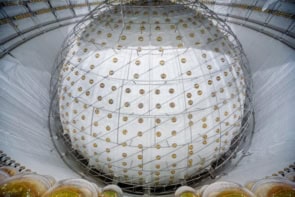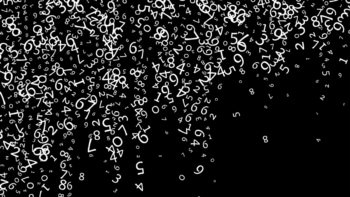
An unusual form of symmetry known as E8 – which some physicists believe underlies a theory of everything – may have been spotted in a solid material for the first time. Physicists in Germany and the UK claim to have shown that the 8D symmetry group describes the spectrum of spin configurations that emerge when a 1D chain of spins is chilled to near absolute zero and subjected to a specific magnetic field. The experimental work also confirms a long-standing prediction of the spectrum at zero magnetic field.
Symmetry plays a fundamental role in our understanding of the physical world. Perhaps the most intriguing of all is E8 – essentially a fantastically beautiful 8D diamond-like lattice of spheres in which each sphere is surrounded by 240 others. E8 shot to fame in 2007 when the US freelance physicist Garrett Lisi, who has an unlikely day-job as a surfer in Hawaii, posted a paper on the arXiv preprint server suggesting that E8 could underpin a theory of everything by mapping out all known particles and how they interact with each other.
However, E8 had fascinated researchers well before Lisi’s paper appeared. In 1988 the Russian physicist Alexander Zamolodchikov showed that E8 symmetry could – under certain conditions – also describe the spectrum of spin excitations that occur in 1D Ising ferromagnets. These are chains of spins in which each spin can only interact with its two nearest neighbours. Below a critical temperature, neighbouring spins tend to align perpendicular to the direction of the chain in one of two directions (up or down).
Quantum fluctuations
If a magnetic field is applied perpendicular to the spins, it will encourage spins to flip spontaneously – or tunnel – between up and down. Such fluctuations can propagate though a material much like a particle and are therefore referred to as quasiparticles. These quantum fluctuations occur even at zero temperature and, if the field is strong enough, ferromagnetism is destroyed in a quantum phase transition.
Now, Radu Coldea of Oxford University and colleagues at the Helmholtz Zentrum Berlin (HZB), the University of Bristol and Rutherford Appleton Laboratory have measured the energies of several of these quasiparticles. They did this by cooling the sample of cobalt niobate to 40 mK and firing neutrons at it to create quasiparticles. When this occurs, the spin and energy of the scattered neutrons change relative to the incident beam by an amount that can be used to calculate the energies of the quasiparticles.
When the experiment was done at zero magnetic field, five quasiparticles were spotted. Their energies are described not by E8, but by a mathematical formula derived three decades ago by Barry McCoy and Tai Tsun Wu. McCoy, who is at Stony Brook University in New York, told physicsworld.com that he was “very impressed with the experiment and most gratified to see that our prediction of 1978 has been experimentally observed”.
‘Golden ratio’
Coldea and colleagues then repeated their measurements in a magnetic field. As the strength of the field was increased to the quantum critical value of 5.5 T, the ratio of energies of the first two quasiparticles approached 1.618. This number is the “golden ratio” and is precisely what should be measured if the quasiparticles are described by E8 – a prediction that was made more than 20 years ago by Zamolodchikov, now at Rutgers University.
Unfortunately the team was unable to study the system at the quantum critical field – where E8 should emerge – because they could only resolve the lowest energy quasiparticle above about 5 T. Although E8 predicts a total of eight quasiparticles, McCoy believes that it will be very difficult to use neutrons to see the higher energy quasiparticles. This is because their energies overlap a region dominated by continuum scattering involving two or more quasiparticles.



